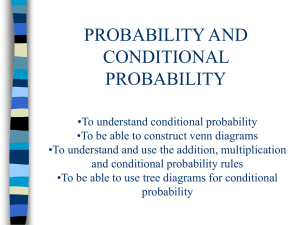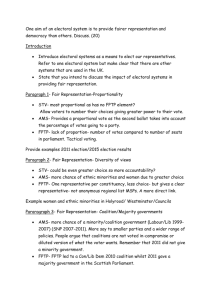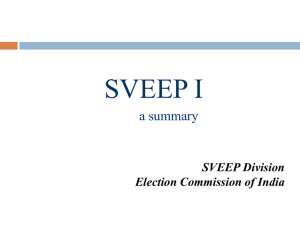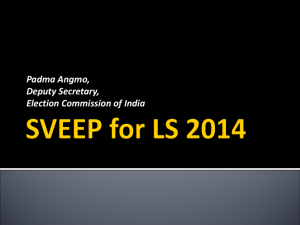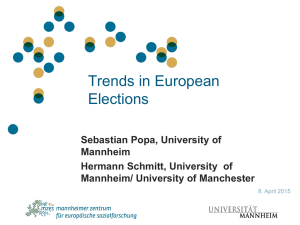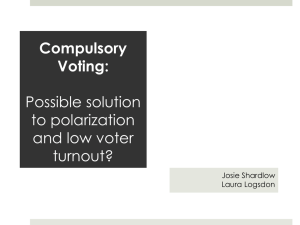Drafting the Data and Methods Section
advertisement
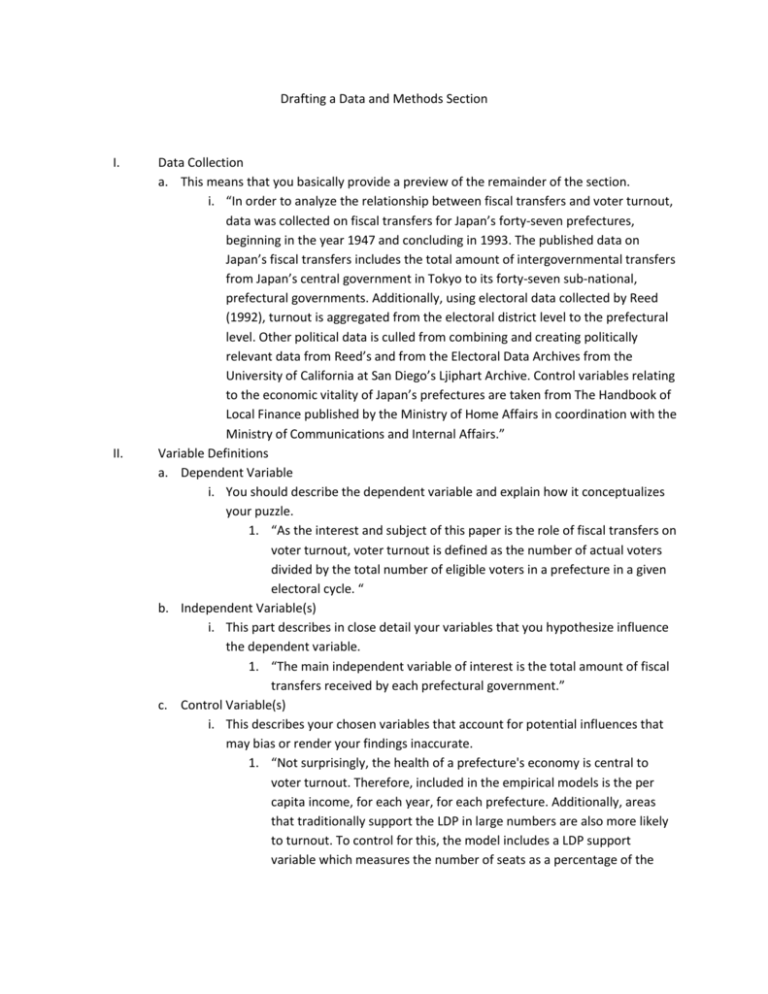
Drafting a Data and Methods Section
I.
II.
Data Collection
a. This means that you basically provide a preview of the remainder of the section.
i. “In order to analyze the relationship between fiscal transfers and voter turnout,
data was collected on fiscal transfers for Japan’s forty-seven prefectures,
beginning in the year 1947 and concluding in 1993. The published data on
Japan’s fiscal transfers includes the total amount of intergovernmental transfers
from Japan’s central government in Tokyo to its forty-seven sub-national,
prefectural governments. Additionally, using electoral data collected by Reed
(1992), turnout is aggregated from the electoral district level to the prefectural
level. Other political data is culled from combining and creating politically
relevant data from Reed’s and from the Electoral Data Archives from the
University of California at San Diego’s Ljiphart Archive. Control variables relating
to the economic vitality of Japan’s prefectures are taken from The Handbook of
Local Finance published by the Ministry of Home Affairs in coordination with the
Ministry of Communications and Internal Affairs.”
Variable Definitions
a. Dependent Variable
i. You should describe the dependent variable and explain how it conceptualizes
your puzzle.
1. “As the interest and subject of this paper is the role of fiscal transfers on
voter turnout, voter turnout is defined as the number of actual voters
divided by the total number of eligible voters in a prefecture in a given
electoral cycle. “
b. Independent Variable(s)
i. This part describes in close detail your variables that you hypothesize influence
the dependent variable.
1. “The main independent variable of interest is the total amount of fiscal
transfers received by each prefectural government.”
c. Control Variable(s)
i. This describes your chosen variables that account for potential influences that
may bias or render your findings inaccurate.
1. “Not surprisingly, the health of a prefecture's economy is central to
voter turnout. Therefore, included in the empirical models is the per
capita income, for each year, for each prefecture. Additionally, areas
that traditionally support the LDP in large numbers are also more likely
to turnout. To control for this, the model includes a LDP support
variable which measures the number of seats as a percentage of the
prefectural district magnitude. Finally, the model includes the logged
population of each prefecture for each year.”
III.
IV.
V.
Summary Statistics
a. You should make a table of these variables (Or, the ones you have collected) and
provide the mean, standard deviation, and number of observations.
Estimation Procedure
a. Provide the basis for presenting your correlation coefficient. In the spring, this section
will be more complex, but for how the correlation is calculated is good enough.
i. “Although methodological advances made by political scientists are numerous,
addressing the possible pitfalls presented by Time-Series Cross-Sectional (TSCS,
henceforth) data requires the careful attention. While some have argued that
the distinction between Panel Data (Henceforth, PD) and TSCS is substantial, for
our proposes, PD refers to data that is dominated by cross-sections such that
the relationship between the number of cross-sections, N, and units of time, T,
are denoted by $N>T$. When a reference is made to TSCS data and estimation,
the relationship between N and T is more equitable. In the bulk of empirical
studies of comparative politics, T numbers more than thirty for each cross
sectional unit. While the shape of the data matrix is not required to be
rectangular, usually TSCS data is more rectangular than studies utilizing a
greater number of cross section units than temporal units. To begin, our
modeling derives its constraints and corrections from a basic function form of
data that uses cross-section over time. Where $\alpha$ represents a constant
and $\beta_{1}y_{t-1}$ is the combinations of the coefficient and the lagged
value of the dependent variable, turnout. Independent variables
$x_{1}$ through $x_{4}$ are used to make predictions of voter turnout. Finally,
$\epsilon$ represents an i.i.d error term. As the main pitfall of TSCS and PD
studies centers on the distribution and determination of the error term, without
addressing the potential problem, the empirical model should be viewed with
healthy skepticism. Of most concern is the relationship between the dependent
variable and the error term and the relationship between the temporal domain
and the error term. As the dependent variable was correlated with the error
term, the model includes a lagged dependent variable. While there is much
debate regarding the use of dependent variables, Beck and Katz (2009) show
that in almost all cases, the inclusion of lagged dependent variable corrects for
the problem and yields only slight loss of explanatory power. Additionally, when
a lagged dependent variable is included, the relationship, while not perfectly
gone, is reduced by a substantial margin. On the other front, the relationship
between the temporal domain and the error term is quite small, $-0.02$.
Additionally, because Japan's turnout data is unbalanced, the only statistical
tool that provides evidence either in the negative or affirmative regarding
stationarity is a Fisher-type test (Madalla and Wu, 1999).”
Results
a. What is the relationship between your variables through statistical measures?
i. “As Table 3 shows, when controlling for other relevant factors, the amount of
fiscal transfers received by prefectural government is a positive and significant
factor on aggregate voter turnout. To provide robust findings and to eliminate
the possibility that the relationship between fiscal transfers and turnout is
based upon a single estimation technique, Models 1-3 use different estimation
techniques in terms of estimation, correlation structure of the data which may
bias standard errors, and the procedures for calculating standard errors which
estimate the importance and statistical significance of the independent
variables. In model 1, turnout is estimated using the Panel Corrected Standard
Errors approach widely utilized by those using panel and time-series crosssectional data with continuous or “as-if” continuous dependent variables,
originally conceived by Beck and Katz (1995). Additionally, it specifies that the
correlation structure as panel-specific errors with a one period autoregressive
tendency. While the data on fiscal transfers commences in 1947, since the
appearance of the LDP as a dominant party, only begins in the aftermath of the
1955 election, the data analysis starts from that point. Additionally, from 19551993, 18 elections occurred. Testing for both serial correlation and stationarity
revealed that although autocorrelation exists, the inclusion of a one-period
autoregressive tendency resolves the issues created by the nature of the data
generating process. In the second model, the only change is that to ensure
robust specifications and an absence of specification bias, we include AR1 that
are exchangeable throughout our panels. Finally, the use the Generalized
Estimating Equation advocated by Zorn (2001) and put into practical use by
numerous authors (Bennett and Stam, 2000; Bliss and Russett, 1998; Caldeira,
Wright and Zorn, 1999; Oneal and Russett, 1999a, 1999b). Not surprisingly, the
lagged dependent variable constituting turnout in the previous election is a
strong and positive indicator of turnout in the current time period. Additionally,
contributing to the theme that the LDP was able to turnout voters in areas
where they are strongly supported is also confirmed by the three models.
However, the electoral support the LDP is also used to control for the fact that it
may be difficult to unravel the relationship between the difference between LDP
favoritism and fiscal transfers as influences of turnout if both variables are not
included in the model. While the interpretations of the first two independent
variables are quite straightforward, the influence of income on turnout is mixed.
In two models, it is negative and statistically significant, but in the model that
assumes the error term is structured as a panel-exchangeable AR1, the
coefficient is positive, but not significant. Finally, as most predict, the rural bias
of the LDP is confirmed through the logged value of prefectural population. As
the logged population of a prefecture decreases, as is true in most rural
prefectures, the turnout increases. Finally, as expected, the connection between
fiscal transfers is positive and significant. As prefectures receive more in aid
from the central government aggregate turnout increases without regard to
level of electoral support.”

